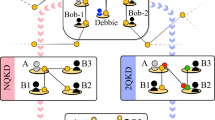Abstract
This paper presents a novel cascaded conference network that provides distributed processing and signal transmission among members of disjoint sets of generic send/receive devices called conferees. It assumes an online request model in which idle groups of conferees may request the formation of a conference interconnection. Once a conference is established, all conferees remain connected until the entire conference is dissolved. The Hypercube Sandwich Network (HSN) consists of two components. A bidirectional permutation network is used for routing purposes to and from a hypercube of special processing elements for the purpose of conference formation. The HSN achieves strictly nonblocking performance for N conferees using O(N√log N) processing elements, and this is shown to be tight to within a log 1/4 N factor. Previous constructions required a quadratic number of processing elements for strictly nonblocking performance or could only provide wide-sense nonblocking conferencing. If the stronger requirement is made that the communication delay is logarithmic in the conference size, a simple algorithm is presented for wide-sense nonblocking conferencing in an HSN with O(N log N) processing elements.
Similar content being viewed by others
References
H. L. Abbott and M. Katchalski. On the snake in the box problem. Journal of Combinatorial Theory, Series B, 45: 13–24, 1988.
R. Ahlswede and K.U. Koschnick. Note on an extremal problem arising for unreliable networks in parallel computing. Discrete Mathematics, 47: 137–152, 1983.
B. Becker and H.-U. Simon. How robust is the n-cube?Information and Computation, 77: 162–178, 1988.
V.E. Beneš. Mathematical Theory of Connecting Networks and Telephone Traffic. Academic Press, 1965.
J. Bruck, R. Cypher, and D. Soroker. Tolerating faults in hypercubes using subcube partitioning. IEEE Transactions on Computers, 41(5): 599–605, 1992.
D.G. Cantor. On non-blocking switching networks. Networks, 1: 367–377, 1972.
P. Feldman, J. Friedman, and N. Pippenger. Wide-sense nonblocking networks. SIAM Journal of Discrete Mathematics, 1(2): 158–173, 1988.
J.F. Houlahan, L.J. Cowen, and G.M. Masson. Hypercube sandwich approach to conferencing. In Proceedings of the International Conference on Parallel and Distributed Processing Techniques and Applications '95, pp. 481–490, 1995.
J. F. Houlahan. Sandwich networks for conferencing. Ph.D. Thesis. Johns Hopkins University, Department of Computer Science, 1996.
F.K. Hwang. Rearrangeability of multi-connection three-stage Clos networks. Networks, 2: 301–306, 1972.
F.K. Hwang. Three-stage multiconnection networks which are nonblocking in the wide sense. Bell System Technical Journal, 58(10): 2183–2187, 1979.
F.K. Hwang and A. Jajszczyk. On nonblocking multiconnection networks. IEEE Transactions on Communications, COM-34(10): 1038–1041, 1986.
A. Jajszczyk. Comments on “Three-stage multiconnection networks which are nonblocking in the wide sense”. Bell System Technical Journal, 62: 2113–2114, 1983.
D.J. Kleitman. On a problem of Yuzvinsky on separating the n-cube. Discrete Mathematics, 60: 207–213, 1986.
F.T. Leighton. Introduction to Parallel Algorithms and Architectures: Arrays, Trees, Hypercubes. Morgan Kaufman, 1992.
J.S. Turner. Practical wide-sense non-blocking generalized connectors. Washington University Technical Report WUCS-88-29, 1988.
J. Wojciechowski. A new lower bound for snake-in-the-box codes. Combinatorica, 9(1): 91–99, 1989.
D.R. Woodall. The Bay Restaurant—A linear storage problem. American Math. Monthly: 240–246, March 1974.
Y. Yang and G.M. Masson. Rearrangeable broadcast ring sandwich networks. IEEE Transactions on Computers, 44 (10): 1169–1180, 1995.
E. W. Zegura. Analysis of switching networks for multiport and multivariate communication. Ph.D. Thesis, Washington University, 1993.
Author information
Authors and Affiliations
Rights and permissions
About this article
Cite this article
Houlahan, J.F., Cowen, L.J. & Masson, G.M. Hypercube sandwich approach to conferencing. J Supercomput 10, 271–283 (1996). https://doi.org/10.1007/BF00130110
Issue Date:
DOI: https://doi.org/10.1007/BF00130110




